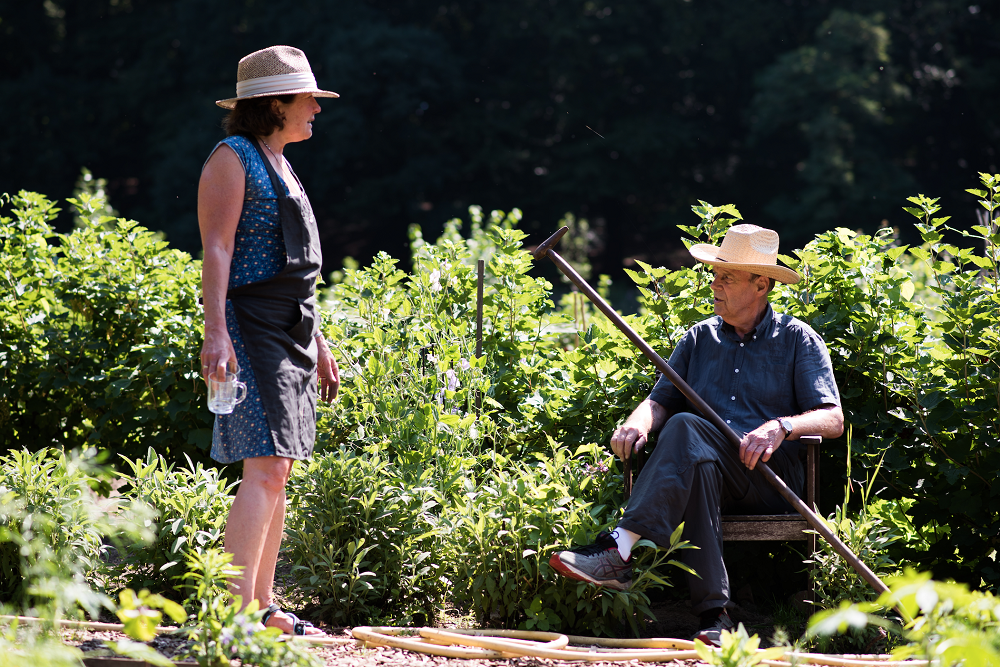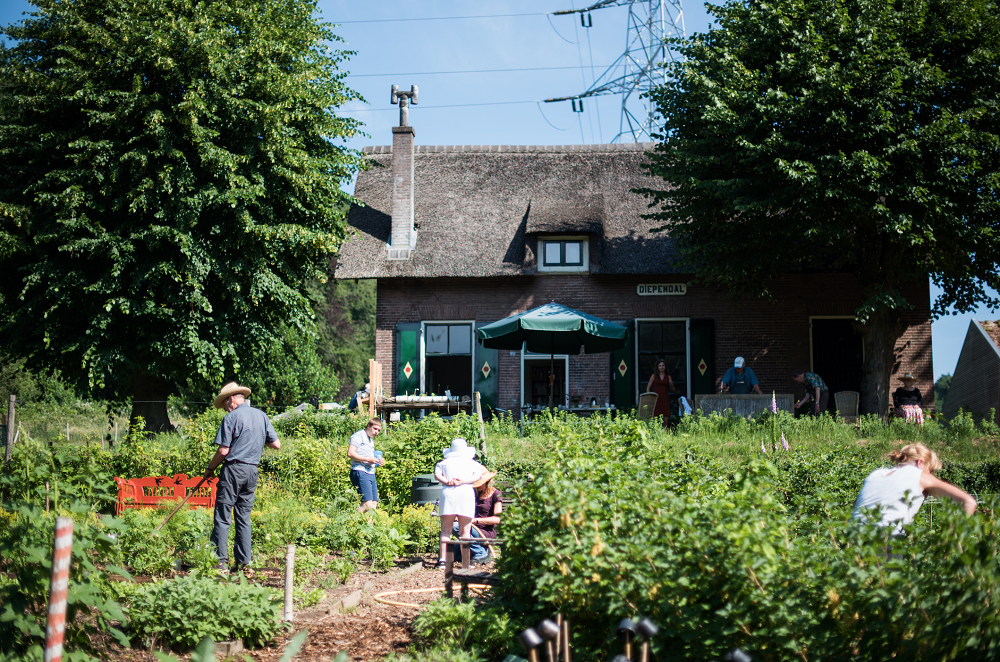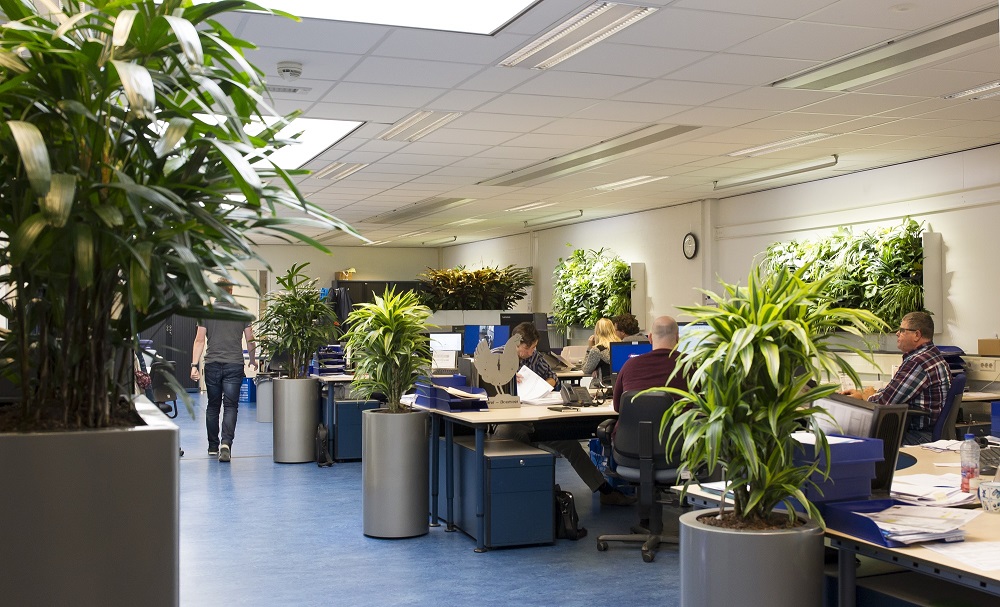
Longread
A green environment: good for your health
Whether a short stroll or spending hours wandering in nature, growing vegetables together in a community vegetable garden or working in an office full of plants: a green environment feels good. And greenery IS good. Contact with nature increases happiness and reduces stress. It promotes vitality and creativity and stimulates human interaction. That is why researchers at Wageningen University & Research (WUR) are working on a number of Green Impact for Health projects.
When the relationship between vegetation and health was researched in the 1980s, the findings were so remarkable that leading journal Science (1984) reported on them. The American Roger Ulrich demonstrated that patients who had a view of green trees following gallbladder surgery recovered faster than those who looked out at a brick wall. This study paved the way for a wealth of research into the healing effect of nature. ‘Dutch research also reveals that people living in a green environment often feel healthier and suffer less illness. Vegetation reduces stress in various ways, including the mere fact that looking at nature has a calming effect. Vegetation stimulates human interaction and encourages children to engage in more varied play,’ says researcher Sjerp de Vries. ‘Children in green neighbourhoods, for example, are fifteen per cent less likely to be overweight.’
Vegetation and the use of ADHD medication by children
The greener the living environment, the fewer children aged five to twelve years who are taking ADHD medication. Working with two health-related research institutes, NIVEL and the Julius Center (UMC), WUR has looked into the relationship between how green the living environment is and the use of ADHD medication such as Ritalin. Data from the Achmea Health Database on nearly 250,000 children were used. The living environment is defined as a circle with a radius of 250 metres around the home.
The greener the living environment, the lower the incidence of use of ADHD medication in this age group. The relationship was strongest in the poorest neighbourhoods and absent in the wealthiest neighbourhoods (based on the property value of the homes). These findings are consistent with those of other research, which also found a stronger link between the presence of vegetation and health among those with a lower socio-economic status.
If you would like to know why children in a green environment take less ADHD medication, read: More green, less ADHD (but only in poor neighbourhoods) (in Dutch).
Green space in the living environment
But not everyone has easy access to a garden, a park or green spaces in their neighbourhood. ‘For vulnerable groups, such as the elderly and people with low socio-economic status, green space has an important benefit,' says researcher Jan Hassink. 'It improves health and wellbeing, and access to green spaces can help reduce socioeconomic health disparities. These are differences in health and mortality between people with a high and people with a lower socio-economic status in society. Yet the latter group often lacks easy access to green spaces. Moreover, the quality and level of maintenance of green spaces in their living environment is often lower, which means the green space is likely to have a less positive impact. On top of that, this group has a more limited action range and pays fewer visits to a forest further from home.'
For this reason, the researchers are looking into how they can work with residents to make disadvantaged neighbourhoods in Arnhem and Nijmegen greener, so that all residents have more contact with green areas and actively use them. Researcher Lenneke Vaandrager is a project leader in the PARTIGAN consortium: ‘We are investigating how residents use and appreciate parks. We are monitoring redevelopment projects that are creating greener streets and we are assessing the impact on health and wellbeing. And we want to know residents' views on green citizens' initiatives. These are initiatives like community gardens established by residents themselves, where they all roll up their sleeves and prepare meals using vegetables and herbs from their own garden. What we expect to see is that, when people work in the vegetable garden, they have more social interaction, experience less stress and feel healthier. We want to monitor if they also live more healthily, because they are more active and eat healthier.’
- Read more about the Partigan project
In the project 'A green garden, a healthy garden' we currently collaborate with Netherlands Institute for Healthcare Research (Dutch acronym: NIVEL) to study whether a green garden at home contributes to healthy city dwellers. Project leader Sjerp de Vries: 'We expect that green in privately owned gardens forms a significant part of the total amount of available green, due to the special relation people have with their 'own' flora, and its proximity. An additional question is whether a lack of such private vegetation can be compensated by public parks located near or in residential areas.' A large number of municipalities are currently being surveyed to determine whether there is a garden present, how large this garden is and how much vegetation it contains. Detailed aerial photographs provide this information. These photographs are also used to map any other vegetation nearby. In a second step, this data is linked to NIVEL data on the health of some 2 million inhabitants. This will allow for analysis of links between the two.
Healthy greenery in and around schools
It is not just in Arnhem and Nijmegen that residents will have the opportunity to engage more actively with nature and eat healthier. Children in Amsterdam are seeing daily how apples and pears grow in the school orchard and how they can help out with the maintenance of the trees and the harvesting of the fruit. Here, WUR is involved in Fruit4Schools, an initiative that introduces parents and children to healthy food in a fun and, above all, natural way. Primary and secondary schools, local businesses, municipalities and other interested parties are working together to produce fruit on school grounds. Project leader Marc Ravesloot: ‘This is tied in with environmental education: the children eat the fruit they have grown in class, supplemented if necessary by the local greengrocer's. Children and their parents gain a greater awareness of how the food they eat each day is produced and the impact of healthy food on their wellbeing.’
Getting enough exercise is also part of a healthy lifestyle. For this reason, a number of schools are being transformed into ‘Healthy Schoolyards’. A healthy schoolyard is one where you can hide in the bushes, clamber over tree trunks or stomp in puddles with your wellies on. Basically, it is a place where children have space to play in a challenging and green environment. Together with TNO, WUR has carried out research at four primary schools to assess the impact of such redevelopments. The researchers looked at the degree of physical activity, cognitive functioning, the social climate in the schoolyard and in the classroom and, more generally, the children's social and emotional wellbeing. What they found was that, according to the children, there is less bullying in the playground and fewer children are left out during break time, probably due mainly to the greater variety of play opportunities offered by the new schoolyards.
Read more about Healthy Playgrounds:
Green health(y) care
Not only schools are swapping their grey flagstones for plants and trees. This is also happening in the care sector. ‘Clients are working in places such as care farms, of which there are now 1,200 in the Netherlands,' says Jan Hassink. 'They feed the animals or work in the vegetable garden. The farmers provide the care. The tranquillity and open space of the countryside boost the clients’ wellbeing: they experience less stress, fear or pain. These activities are popular among various groups of clients, such as people with learning disabilities or psychological problems, vulnerable elderly people and young people with behavioural and emotional problems. It is an opportunity for them to participate in society in a meaningful way.’

The researchers want to know what participants and their caregivers think of this type of care. ‘Participants used to be housed in care institutions but nowadays, the care is chiefly provided at home. This is only feasible if the burden on the carers is eased, for instance by making suitable daytime activities available. Together with stakeholders, we are looking at the operative principles and points for attention and improvement which, together, we are using to create a quality framework for care farming,’ says Hassink.
Meaningful daytime activities are also important to people living at home with dementia and their caretakers. According to Vaandrager, it is still difficult finding suitable day care. ‘When looking for daytime activities, you often find the options limited to games and coffee. A lot of people with dementia really benefit from something different. They are happier when they are active, are outdoors for much of the day and can choose themselves what they want to do. We have seen a number of green initiatives popping up in cities recently, from gardening to looking after animals. As this is a relatively new type of daytime activity, we still know little about the diversity and value of these green initiatives. The aim of our research is to investigate the characteristics of green initiatives in urban areas and find out the significance of these green initiatives for people with dementia and their caretakers.’
Read more about green initiatives in cities:
Examples of green daytime activities in cities and the feedback from participants
“Pluk de vruchten” picking garden in Nijmegen is a historical garden with an orchard, greenhouses and vegetable gardens. The activities are based around healthy eating, exercise and gardening. Participants (people with dementia) sow, plant, weed and harvest and help prepare meals which they then eat together. It is the initiative of a social entrepreneur.

Hoeve Klein Mariëndaal in Arnhem is an urban farm with a nursery, a flower and herb garden, a tearoom and a variety of animals roaming around, including a donkey, chickens and rabbits. With the support of a creative therapist and volunteers, people with dementia can choose from a range of activities such as gardening, walking and painting.
‘I am standing here in my boots, just doing outdoor work, like a kind of farmer. With a spade and a shovel. Then when I go home at the end of the day, I feel great. (Participant, age 61)
‘I do not really feel like a client, it is more like I just work there. And that is how they treat me there too. I can do things independently.’ (Participant, age unknown)
Green spaces and city heat
Green spaces also keep us feeling comfortable on a warm summer’s day in the city. A good quantity of urban vegetation, spread over a wide area, counteracts city heat. WUR researched the contribution made by urban vegetation to what is termed thermal comfort: how pleasant, or unpleasant, the combination of temperature, wind, humidity and radiation feels. The conclusion is unambiguous: urban vegetation helps to make us feel "thermally" comfortable. Water or the shade of buildings are not, in our perception, in the same league as trees when it comes their cooling effect. The measurement data collected by cycling around on two cargo bikes loaded with measuring equipment also reveals that green spaces are islands of cool in a city. Ten per cent more tree cover results, for example, in an air temperature that is at least three degrees lower. Because of climate change, heat in cities will increase and thermal comfort will become a more important issue when designing outdoor spaces.
Plants and the indoor climate
The air that we breathe outdoors on a sunny day is often of better quality than the air indoors, which, frankly, is often of poor quality. This is due to poor ventilation, high concentrations of CO2 and volatile substances that are emitted by things like carpets, wall panels or electronic devices. Sick building syndrome first emerged as a concept in the 1980s. Unhealthy indoor air causes health complaints such as headaches, irritation to the mucous membranes and allergies. ‘Healthy air plays an important role in creating a good learning environment for children and a good working environment for employees,' says project leader Tia Hermans. The more CO2 there is in the air, the harder it is to concentrate. You can use green plants to purify the indoor air and increase job satisfaction.
Green rehabilitation for young employees suffering burnout
Burnout is increasingly common among young people aged between 18 and 35 years. Work stress-related absence costs the Netherlands around €1.8 billion. Recent research has revealed that green rehabilitation programmes, such as walking coaching, can reduce burnout complaints and promote reintegration. That said, there are still lots of questions about the effectiveness of the programmes and the mechanisms at play, so health insurers do not recognise this form of care. The aim of Roald Pijpker's PhD research, therefore, is to determine mechanisms which might explain the rehabilitation of young employees suffering burnout. It also investigates whether programmes based on those mechanisms are actually effective.
If you would like to know more about green rehabilitation for young employees suffering burnout, read:
- The potential of green programmes for the rehabilitation of young employees with burnout: a salutogenic approach
So there are advantages to working in a green oasis: it adds moisture to the air and plants can purify the air and create a really nice environment. WUR conducted research in three locations, comparing a control and an intervention room. The results were remarkable: after introducing plants in pots and hanging baskets, the relative air humidity improved by an average of five percentage points and as much as seventeen percentage points in winter. People rate the workplace as more attractive. Since plants were introduced, employees report more positive feelings and are more positive about their own performance. Also, employees call in sick less frequently: the drop is twenty percentage points. However, unexpectedly, their recovery needs after a day at work are higher since the introduction of the plants.

Project leader Tia Hermans adds: ‘These first results are quite promising. That is why, right now, research is underway at nine locations into introducing plants. After all, less artificial climate control (energy saving) or improved employee performance (labour productivity) or reduced absence due to illness can yield economic savings. A green office environment can also benefit a company's image and make it easier to attract customers or staff, or to retain staff. We will know the results of this project in 2021.’
Fact sheets
Much of the research takes place within the framework of the Green Agenda since 2015. It is partially funded by the top sectors, De Groene Stad foundation, and a large number of businesses, civic organisations and local governments. Five fact sheets have been released, containing much information.
Green and safe
Green holds the future. The advantages of vegetation in and around urban areas has on health, habitability and well-being are becoming increasingly clear, and an increasing number of municipalities strive for structural increase vegetation in urban areas. It is vital to not only see the advantages, but also consider possible unforeseen negative effects and consequences, both in terms of health and safety.
Recent years have shown that the oak processionary caterpillar causes quite a nuisance, as well as depletes city budgets due to the costs of pest control. And, it's not just this caterpillar that advances. Did you know that one out of every five tick bites occurs in urban areas? And that the chance of getting bitten by mosquitoes is significantly greater? Water quality is also an issue deserving of attention, particularly as a result of the long hot spells. Consider issues such as blue-green algae, botulism and leptospirosis. Moreover, hay fever is significantly exacerbated through interaction between air quality and pollen.
Several publications (Lohmus 2015, WHO 2017) have shown that these effects and consequences are hitherto insufficiently considered in design and management. Clear design guidelines and restrictions are lacking. Innovations often occur faster than adjustments to legislation and design guidelines. Thus, we are currently discussing with the safety sector, such as the fire department, about the potential risks of having green façades and roofs, and how to address this issue.
Researcher Bertram de Rooij: 'In the coming period we will focus on this aspect of vegetation and health, so that we don't just monitor the developments, but can also provide a positive and practical solution. Thus, we can face and neutralise the possible risks and unintended consequences, and continue to value the positive side of vegetation.'
Joining forces for Nature and Health
Wageningen University & Research researchers work with municipalities, businesses and civic organisations to make vegetation an even more fixed part of preventive health care, Marian Stuiver, programme leader Green Cities: 'The fact that the value of vegetation for health is increasingly recognised by the Top Sectors and ZonMw, is a positive development. But we have a long way to go. Both in research as in indoor and outdoor design.'